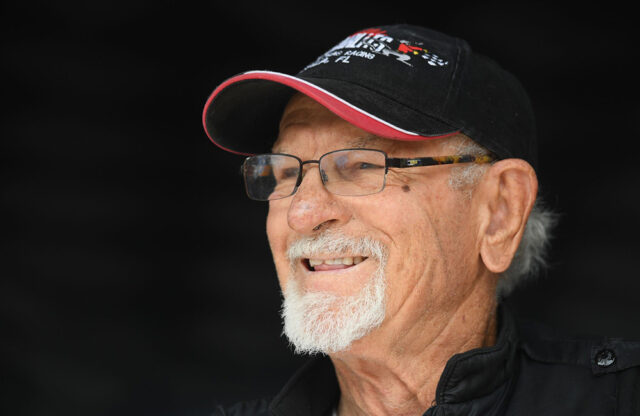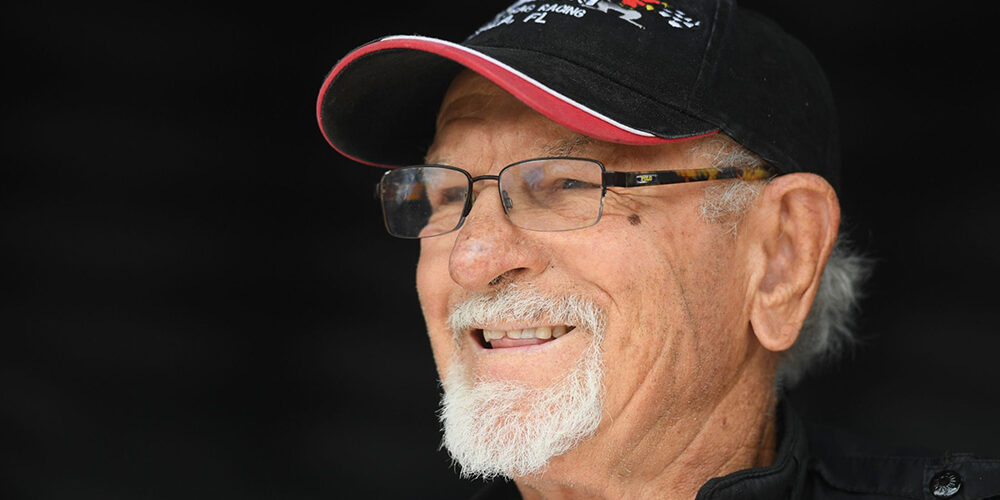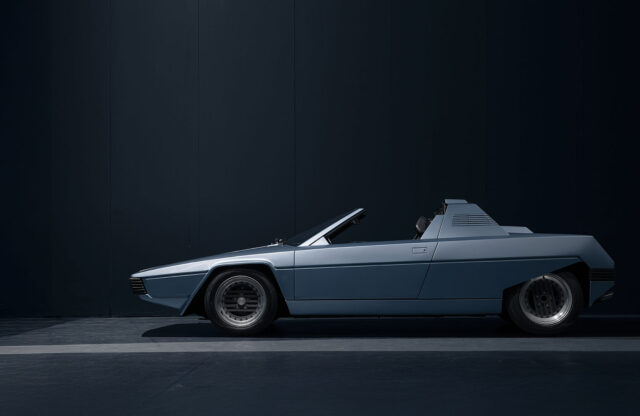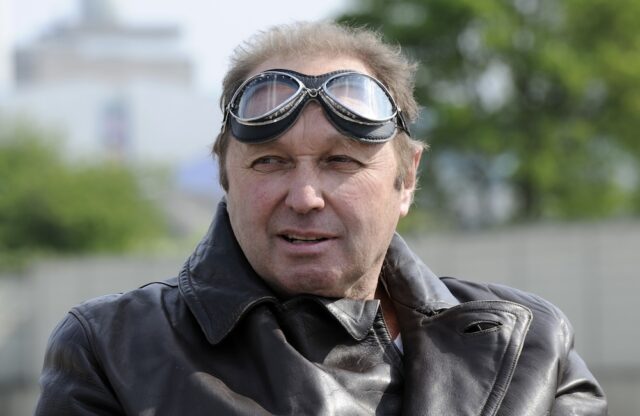The Petersen Automotive Museum has honoured drag-racing legend Don Garlits with its Robert E Petersen Lifetime Achievement Award at the 2025 SEMA Industry Honors event.
Don ‘Big Daddy’ Garlits, now 93 years old, was a pioneering figure in drag racing. Over a career spanning five decades, he secured 35 NHRA national event victories and three NHRA Top Fuel national championships. Beyond his success on the track, Don Garlits was a major innovator in the sport’s engineering and design. He built the first rear-engine Top Fuel dragster, became the first to apply aerodynamic principles to dragster bodywork, and created the Swamp Rat XXX, the first fully enclosed dragster.
He was also the first driver to officially exceed 200, 250 and 270mph over a quarter-mile.

“Don Garlits set the standard for what a true drag racer could and should be,” said Terry L Karges, executive director of the Petersen Automotive Museum. “He is a legend both on and off the drag strip, and we look forward to presenting him with this award.”
The award, named after the founder of the Petersen Automotive Museum, has previously been presented to figures such as Dan Gurney, Art Chrisman, Carroll Shelby, George Barris, Andy Granatelli, the Ford family, Vic Edelbrock, Jack Roush, Ed Iskenderian, So-Cal Speed Shop founder Alex Xydias, Dr Wolfgang Porsche, William Clay Ford Jr, Richard Petty, Wally Parks, Roy Brizio and Don ‘The Snake’ Prudhomme.

“I am deeply honoured to be recognised by the Petersen Automotive Museum, and to join such a distinguished list of past recipients,” said Don, who founded the Don Garlits Museum of Drag Racing in Ocala, Florida. “Southern California has an extraordinary racing heritage, and the Petersen has done an outstanding job of uniting the global automotive community in the heart of Los Angeles.”
Magneto editor David Lillywhite interviewed Don for Octane magazine – which you can read below.
As we cruise into the small Florida town of Ocala, I’m reminded of a meeting in the UK with Don Garlits in 2014. With tears in his eyes, he explained how he’d prayed for God’s help finding a location for the museum, and the next morning had been guided to this very place.
Daughter Donna and wife Lisa are behind the museum’s reception desk, full of Southern charm. A knock on the office door behind them prompts a growl from within, and we head through to be reunited with Don Garlits, who is busy at his desk signing memorabilia for the gift shop, pictures of his cars in action filling the wall behind him.
He’s still tough and wiry [he is at 86 years old at the time of writing], and his eyes blaze as he tells us about the museum. His accent is strong, his voice theatrical with enthusiasm as he pauses dramatically, lowers to a hush, brings the story back with a crescendo. We’re held spellbound and occasionally bemused by the man who has won 144 National races and 17 World Championship titles – and cheated death over and over.
We start with the formation of the museum in 1976, by which time Don had already been racing for 16 years and achieved worldwide fame for his exploits, not least being the first officially to achieve over 200mph in a quarter-mile.
“We were racing in England at Santa Pod,” he says. “I had a week off, and they took my wife [Pat, who died in 2014 after a battle with Parkinson’s and dementia] and me about the British countryside, to the car museums. I was looking in a case and it said: ‘These are the nail clippers that Stirling Moss used before he won the Mille Miglia.’ I just thought to myself, ‘Gosh, I’ve got a lot of stuff like that, we ought to have a drag-racing museum.’ Les Brooks, a dear friend, he says, ‘Well, why don’t you build one?’, just as nonchalant as if he were saying, ‘Why don’t we go get a cup of coffee?’
“So on the flight back, my wife and I discussed it and we decided to invest in it. We built a 12,000-square-foot building and put everything in it. And for six years we had no visitors! My wife was the controller of the business. So six years we’re down there with these no visitors, and she says, ‘Honey, what are we going to do with that white elephant that we’ve created when you don’t race any more and can’t support it?
“I said I always thought I’d move it to the Interstate. She just turned ashen white. She said, ‘We’re living on your father and mother’s property that they hacked out of the wilderness in 1927. Under that big oak is the swing your daddy put up for you in 1938. The lake down there, the citrus trees your mom and dad planted after they’d cleared the land… you’d leave all this?’ I just kinda thought in our old age that’s what we’d have to do. ‘Well, maybe,’ she said.”
And so Don and Pat went searching for property suitable for a house and museum. They had $80,000 to spend, but they couldn’t find anything, until one night they prayed for help. Next day, Don and Pat turned north onto the busy Interstate 75, and uncovered a fallen-down For Sale sign. For the perfect plot. For $80,000.
“Boy, He sent us straight to it!” Don proclaims, at the top of his voice, emotion still running high. Then he leans closer and drops his voice to a near-whisper. “We don’t know how it all works.”
There’s a long pause. And then we head into the museum, passing Don’s first dragster, the 1956 Swamp Rat 1, on the way in. Swamp Rat? The name came from the slick Californian racers who laughed at Don’s Florida accent and naivety. “It’s my favourite car in the whole world; it made me what I am today,” says Don.

This first room is packed with drag-racing cars and memorabilia. The trophies, many of the cars (including several of the 37 Swamp Rats), the racesuits, the photographs: they’re all his own. But this is a thoughtfully assembled history of American drag racing, so there are also tributes to other racers and tuners, and their cars, trophies and memorabilia, all the better to tell the complete story of the sport.
In the next building over there’s also a large collection of road cars – there are nearly 300 cars in the entire museum – along with an amazing array of engines and carburettors, restored by Don, and thousands of items of memorabilia. He’s on a mission, though, and heads straight for the workshop next to the drag-racing displays. And there’s history here that pre-dates that. “I show people round two or three times a week. It’s about a two-hour tour. I start in the ’shop, tell them a lot of the stories I’ve told you, and get on to all of my stuff that I’ve made. They love it! We’ve saved everything. We have a complete machine shop, and the newest machine in there is from 1967.”
Don had always loved cars, and he soon started his own business fixing them, working alongside his brother, just out of the Marines, with wife Pat running the business side. “There’s a machine here in the shop, a Stewart-Warner balancer; the vintage is 1957, not even a year after our shop opened. At the time I was driving to Miami to get my engines balanced by Jim Rathmann, an Indianapolis 500 winner. I’d put the parts in my car at four in the morning, drive to Miami, he’d personally balance the parts, and then I’d be home by midnight.
“The dealer for Stewart-Warner stopped by and said we should have our own balancer. I said, ‘That’s right, but those things cost $7000!’ In 1957, $7000 could buy you a complete two-bedroom home on two lots.
“He said, ‘You two boys are the hardest-working young men I have ever seen. I drive past your shop at seven o’clock in the morning and you’re both here working. I drive home at night at 10:00pm and you two boys are still working. When do you sleep?’
“He then said, ‘Stewart-Warner is going to put the best balancer in your shop, no money down and all we want for pay is 20 percent of the balance charge. I’ll come by here once a month, you get out the tickets, and whatever it is, 20 percent, and when it’s paid for it’s yours.’”
Don drops his voice again. “Two years, we had it paid off – it’s still here! Brings tears to my eyes!”
He shows us the 1960 Heliarc welder used to build every car after Swamp Rat 1, his beloved Bridgeport milling machine, his tools. Then we head outside the workshop, and walk across to another building as Don returns to the story of the current museum’s early days.
“We bought the plot in 1982, and by March of ’83 everything was in this one building, and we’d run completely out of money. We were out on the aprons here, building the half-walls, and a couple drove in with three youngsters, and the man said, ‘Is this the drag-racing museum?’ I said, ‘Yes it is, but we’re not open yet.’ He said, ‘Mr Garlits, we’ve come a long way, would you mind if we went in and looked around?’ I said that would be $5 each – they were our first paying customers.
“A year later, in March ’84, we had everything nice and we cut the ribbon out front – but from that couple visiting to the ribbon cutting, we’d sold 11,000 tickets, and we weren’t even open. We had 27,000 visitors that year!

Don opens the doors to the next building. This is his private space, for his many projects and engine-builds. “I don’t walk that well [he lost half his right foot when Swamp Rat 13’s transmission exploded in 1970] but I’ve got my own lathe, my own mill, so I can just stay over here.”
One project is a 1948 Ford Siebert limousine, one of three made by Siebert Coachbuilders, which Don has fitted with a Hemi V8 and Torqueflite transmission. “It was pretty sluggish originally,” he grins. “It’s real nice now.”
Then on to another private building, this one packed with drag cars and, all down one side, engines on stands. “When my wife Pat was dying, we had a nurse to look after her in the daytime, and I looked after her during the night. So this is what I did to keep my mind off things.” He heads straight for a flathead V8 from a ’32 Ford, like the rest already plumbed-in to fuel, cooling and electrics. It turns a few times and fires noisily on open headers, as Don enthusiastically explains the technicalities over the din.
And the next: “This is a ’48 Ford truck motor, nothing’s been changed on it, just the Ardun heads – and this causes a 100-horse engine to be one-seventeey-fiiivve… I’ll try to start to start it for ya.” It starts. It’s loud.
Then a supercharged Ford: “Barney Navarro [renowned hot rod engine builder] said to me, ‘I’m sending you a set of aluminium heads for a ’49 253 Ford, I made them special for you. They’re low-compression.’ What would I want with them, I said! He said, ‘Some day, you may want to put them on a blown Ford engine and you’ll need low-compression heads.’ Not much longer after, he died.
“So I saw this [supercharger] kit in Canada and the guy wanted 4000 bucks for it, and I said give it to me, I’ve got just the right Ford for that. This makes about 325 horse.” And Don fires it up, grinning like a kid.
There’s a Ford sedan close by. “This was stock when I got it. Now it’s got a Cadillac engine, because that’s what the moonshiners had, and they were our heroes. They were the ones with the fast cars, who out-run the cops and had all these good-looking women. We called the cars Fordillacs.”

Don’s running out of time – we’ve been with him nearly two hours already – but he can’t resist showing us his electric dragster, which he’s been trying to get to 200mph. It goes back to 1990, when rival drag racer Darrell Gwynn was paralysed after his top fuel car crashed at Santa Pod, UK. Ten years later Darrell’s friends decided to build him an electric dragster, which then led to a charity race between Darrell and Don, each driving electric, joystick-controlled replicas of their 1986 cars to raise money for Darrell’s spinal cord injury charity.
“We were thinking that we’d build these cars to go 100mph and have a nice race. But it didn’t work like that. We had to get it down to 30mph before Darrell could control it.
“So when it was all over I said, “How fast do you think it would go if we took the gloves off?” We thought maybe 200mph…”
That was the seed that led to Don’s Swamp Rat 37 electric dragster. In 2014 he got it to 185.60mph, and he’s still hoping to top 200.
This is pure Big Daddy. He’s a force of nature, and this museum reflects that – even more so when he’s in the house, giving his guided tours. Wherever you sit on religion and politics (and don’t get Don started on UFOs), you have to admire his bravery, ingenuity, showmanship and sheer tenacity. The museum is great, as Don Garlits is more than happy to confirm.
“It’s an American Godly success story!” he proclaims. And with that he’s off, to meet more fans and sign yet more Garlits memorabilia.
For more information on the Petersen Automotive Museum, head here.




